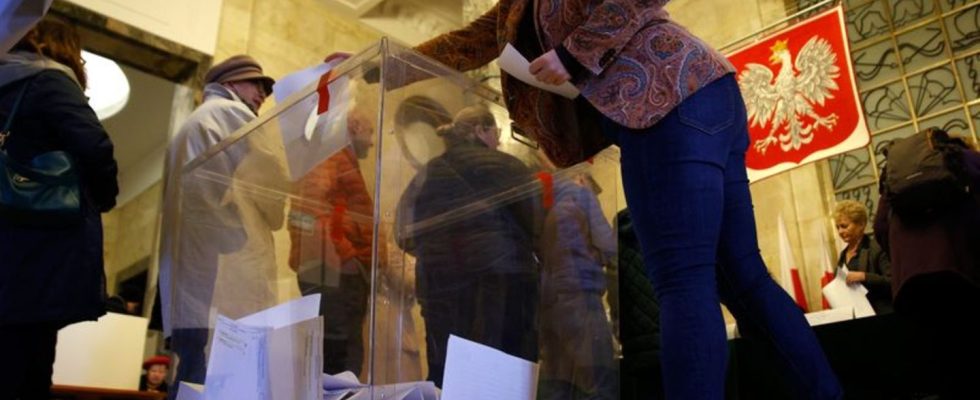Choose
Parliamentary election in Poland: High turnout until the afternoon
Voting at a polling station in Warsaw. photo
© Michal Dyjuk/AP/dpa
Many Poles went to the polls by late afternoon. It could be exciting: The ruling national conservative PiS is in the lead, but Donald Tusk is hot on its heels.
In Berlin, Polish voters also lined up in front of their country’s embassy to cast their votes. The embassy published images on the X platform, formerly Twitter, and wrote that more than 100,000 Poles wanted to vote in Germany. There were large crowds at the embassy and other polling stations, but the vote went smoothly and peacefully.
Initial forecasts about the distribution of the 460 seats in the Sejm and the 100 seats in the Senate, the second chamber of Parliament, are expected after the polls close at 9 p.m. Extrapolations are not common in Poland. The final result is not expected to be announced until Tuesday.
Who will succeed in forming a government?
The most important political dividing line in Poland, an EU and NATO country, runs between the national-conservative PiS, which has been in power since 2015, and the liberal and left-wing opposition, whose largest party is the liberal-conservative Citizens’ Coalition (KO). Predicting the outcome of the election is difficult because the balance of power in parliament can shift by nuances of a few percentage points for smaller parties. A lengthy government formation is expected.
According to surveys, the Prawo i Sprawiedliwosc (PiS, German “Law and Justice”) party is likely to remain the strongest force, but will miss the absolute majority of 231 parliamentary seats. It would then have to rely on the ultra-right Konfederacja to form a government. The Konfederacja rejected a coalition with the PiS during the election campaign. However, many Poles see this as an election campaign tactic and assume that Konfederacja MPs will be lured into the PiS camp with government positions – or that the ultra-right will ultimately tolerate a PiS minority government.
A change of power is also not ruled out. According to the polls, the Citizens’ Coalition (KO) of former Prime Minister Donald Tusk is in second place, close behind the PiS. If she wins the election, she could form a coalition with the left-wing Lewica alliance and the Christian-conservative Third Way. The prerequisite for this, however, is that the Third Way, which consists of a merger of two parties, clears the eight percent threshold that applies to such electoral alliances and enters parliament. In surveys the formation is at a good ten percent.
Additionally vote on four questions
Parallel to the parliamentary election, Poles are voting in a referendum on four questions. One of them deals with the EU asylum compromise. This stipulates that the admission of refugees should no longer be voluntary, but rather mandatory. Countries that do not want to accept refugees would be forced to make compensation payments. The PiS government rejects this.
The specific question in the Polish referendum will be: “Do you support the admission of thousands of illegal immigrants from the Middle East and Africa under the mandatory admission mechanism imposed by the European bureaucracy?” The outcome of the referendum has no influence on the EU decision-making process. The other questions deal with the privatization of state-owned companies, the retirement age and the barrier on Poland’s border with Belarus.

